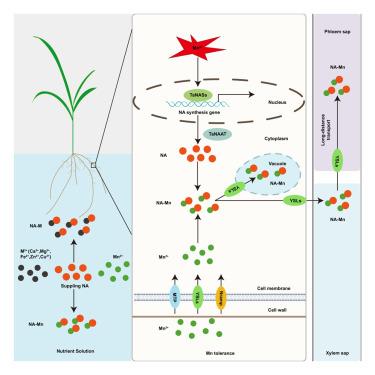Transcriptomic and physiological analyses revealed nicotianamine enhances wheat tolerance to excess manganese
IF 4.1
2区 综合性期刊
Q1 MULTIDISCIPLINARY SCIENCES
引用次数: 0
Abstract
Manganese (Mn) is an essential plant micronutrient but toxic at supra-optimal concentrations. Although nicotianamine (NA) biosynthesis is metal inducible, its specific role in Mn detoxification in wheat remains poorly characterized. Integrated transcriptomic and physiological analyses of Mn-tolerant (ET8, Carazinho) and Mn-sensitive (ES8, Egret) wheat near-isogenic lines and their parental cultivars under excess Mn revealed pronounced upregulation of genes encoding nicotianamine synthase (TaNAS), nicotianamine aminotransferase (TaNAAT), and putative Mn-NA transporters (TaYSL2, TaYSL6) in tolerant genotypes. This transcriptional response correlated with elevated NA accumulation in roots under Mn stress. Exogenous NA application enhanced Mn tolerance in hydroponically grown seedlings in a concentration-dependent manner, accompanied by reduced tissue Mn accumulation, and maintained homeostasis of essential cations (Ca, Mg, Fe, Zn, Cu) in both roots and shoots. Our findings demonstrate that NA biosynthesis and transport contribute to Mn tolerance by modulating Mn partitioning and metal ion homeostasis. We further propose candidate genes (TaNAS, TaNAAT, TaYSL2, TaYSL6) as potential targets for breeding Mn-tolerant wheat.

转录组学和生理学分析表明,烟胺增强了小麦对过量锰的耐受性
锰(Mn)是一种必需的植物微量营养素,但在超理想浓度下是有毒的。虽然烟胺(NA)的生物合成是金属诱导的,但其在小麦锰解毒中的具体作用仍不清楚。对Mn耐受型(ET8、Carazinho)和Mn敏感型(ES8、Egret)小麦近等基因系及其亲本进行的综合转录组学和生理分析显示,Mn耐受基因型中编码烟胺合成酶(TaNAS)、烟胺氨基转移酶(TaNAAT)和推测的Mn- na转运蛋白(TaYSL2、TaYSL6)的基因显著上调。这种转录反应与锰胁迫下根系NA积累增加有关。外源NA以浓度依赖的方式增强了水培幼苗的Mn耐受性,同时减少了组织Mn积累,并维持了根和芽中必需阳离子(Ca, Mg, Fe, Zn, Cu)的稳态。我们的研究结果表明,NA的生物合成和运输通过调节Mn分配和金属离子稳态来促进Mn耐受性。我们进一步提出候选基因(TaNAS, TaNAAT, TaYSL2, TaYSL6)作为选育耐锰小麦的潜在靶点。
本文章由计算机程序翻译,如有差异,请以英文原文为准。
求助全文
约1分钟内获得全文
求助全文
来源期刊

iScience
Multidisciplinary-Multidisciplinary
CiteScore
7.20
自引率
1.70%
发文量
1972
审稿时长
6 weeks
期刊介绍:
Science has many big remaining questions. To address them, we will need to work collaboratively and across disciplines. The goal of iScience is to help fuel that type of interdisciplinary thinking. iScience is a new open-access journal from Cell Press that provides a platform for original research in the life, physical, and earth sciences. The primary criterion for publication in iScience is a significant contribution to a relevant field combined with robust results and underlying methodology. The advances appearing in iScience include both fundamental and applied investigations across this interdisciplinary range of topic areas. To support transparency in scientific investigation, we are happy to consider replication studies and papers that describe negative results.
We know you want your work to be published quickly and to be widely visible within your community and beyond. With the strong international reputation of Cell Press behind it, publication in iScience will help your work garner the attention and recognition it merits. Like all Cell Press journals, iScience prioritizes rapid publication. Our editorial team pays special attention to high-quality author service and to efficient, clear-cut decisions based on the information available within the manuscript. iScience taps into the expertise across Cell Press journals and selected partners to inform our editorial decisions and help publish your science in a timely and seamless way.
 求助内容:
求助内容: 应助结果提醒方式:
应助结果提醒方式:


